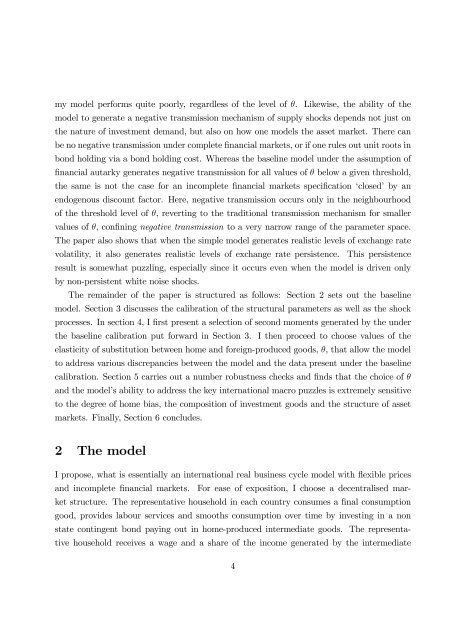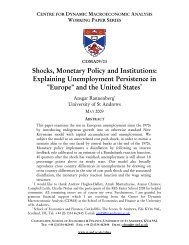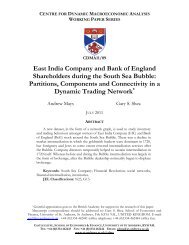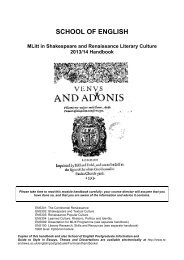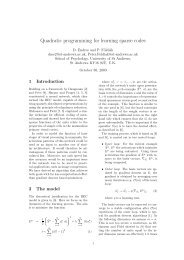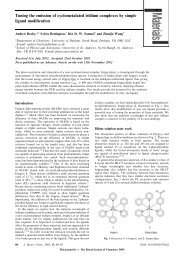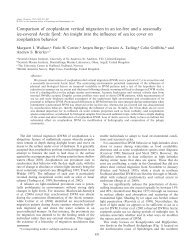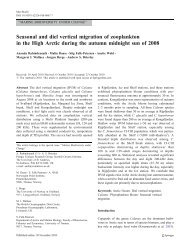Exchange rate dynamics, asset market structure and the role of the ...
Exchange rate dynamics, asset market structure and the role of the ...
Exchange rate dynamics, asset market structure and the role of the ...
Create successful ePaper yourself
Turn your PDF publications into a flip-book with our unique Google optimized e-Paper software.
my model performs quite poorly, regardless <strong>of</strong> <strong>the</strong> level <strong>of</strong> . Likewise, <strong>the</strong> ability <strong>of</strong> <strong>the</strong><br />
model to gene<strong>rate</strong> a negative transmission mechanism <strong>of</strong> supply shocks depends not just on<br />
<strong>the</strong> nature <strong>of</strong> investment dem<strong>and</strong>, but also on how one models <strong>the</strong> <strong>asset</strong> <strong>market</strong>. There can<br />
be no negative transmission under complete …nancial <strong>market</strong>s, or if one rules out unit roots in<br />
bond holding via a bond holding cost. Whereas <strong>the</strong> baseline model under <strong>the</strong> assumption <strong>of</strong><br />
…nancial autarky gene<strong>rate</strong>s negative transmission for all values <strong>of</strong> below a given threshold,<br />
<strong>the</strong> same is not <strong>the</strong> case for an incomplete …nancial <strong>market</strong>s speci…cation ‘closed’ by an<br />
endogenous discount factor. Here, negative transmission occurs only in <strong>the</strong> neighbourhood<br />
<strong>of</strong> <strong>the</strong> threshold level <strong>of</strong> , reverting to <strong>the</strong> traditional transmission mechanism for smaller<br />
values <strong>of</strong> , con…ning negative transmission to a very narrow range <strong>of</strong> <strong>the</strong> parameter space.<br />
The paper also shows that when <strong>the</strong> simple model gene<strong>rate</strong>s realistic levels <strong>of</strong> exchange <strong>rate</strong><br />
volatility, it also gene<strong>rate</strong>s realistic levels <strong>of</strong> exchange <strong>rate</strong> persistence. This persistence<br />
result is somewhat puzzling, especially since it occurs even when <strong>the</strong> model is driven only<br />
by non-persistent white noise shocks.<br />
The remainder <strong>of</strong> <strong>the</strong> paper is <strong>structure</strong>d as follows: Section 2 sets out <strong>the</strong> baseline<br />
model. Section 3 discusses <strong>the</strong> calibration <strong>of</strong> <strong>the</strong> structural parameters as well as <strong>the</strong> shock<br />
processes. In section 4, I …rst present a selection <strong>of</strong> second moments gene<strong>rate</strong>d by <strong>the</strong> under<br />
<strong>the</strong> baseline calibration put forward in Section 3. I <strong>the</strong>n proceed to choose values <strong>of</strong> <strong>the</strong><br />
elasticity <strong>of</strong> substitution between home <strong>and</strong> foreign-produced goods, , that allow <strong>the</strong> model<br />
to address various discrepancies between <strong>the</strong> model <strong>and</strong> <strong>the</strong> data present under <strong>the</strong> baseline<br />
calibration. Section 5 carries out a number robustness checks <strong>and</strong> …nds that <strong>the</strong> choice <strong>of</strong> <br />
<strong>and</strong> <strong>the</strong> model’s ability to address <strong>the</strong> key international macro puzzles is extremely sensitive<br />
to <strong>the</strong> degree <strong>of</strong> home bias, <strong>the</strong> composition <strong>of</strong> investment goods <strong>and</strong> <strong>the</strong> <strong>structure</strong> <strong>of</strong> <strong>asset</strong><br />
<strong>market</strong>s. Finally, Section 6 concludes.<br />
2 The model<br />
I propose, what is essentially an international real business cycle model with ‡exible prices<br />
<strong>and</strong> incomplete …nancial <strong>market</strong>s. For ease <strong>of</strong> exposition, I choose a decentralised <strong>market</strong><br />
<strong>structure</strong>. The representative household in each country consumes a …nal consumption<br />
good, provides labour services <strong>and</strong> smooths consumption over time by investing in a non<br />
state contingent bond paying out in home-produced intermediate goods. The representative<br />
household receives a wage <strong>and</strong> a share <strong>of</strong> <strong>the</strong> income gene<strong>rate</strong>d by <strong>the</strong> intermediate<br />
4


